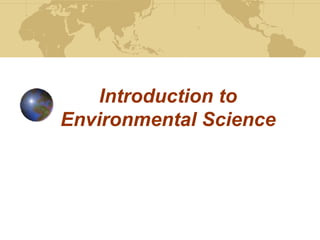
intro to environmental science
- 2. In 1999 scientists studying Costa Rica’s Monteverde cloud forest said they were seeing the disappearance of the golden toad. Why was this occurring? Scientists believe this is one of the earliest indicators of the effects of an increase in temperature due to climate change.
- 3. The theory is that global warming caused the clouds to lift up higher and higher off the mountains. The frogs ran out of mountain, and without the clouds, their environment might have gotten too dry. Increased pollution, and habitat destruction may also play a role in the decline.
- 4. What is Environmental Science? The scientist’s work in Monteverde is just one example of a relatively new field: environmental science. It involves the study of how humans interact with the environment.
- 5. The environment is very complex and differs dramatically from place to place. How humans interact in these environments greatly changes in various parts of the world as well. As a result environmental science is an interdisciplinary science that involves many fields of study in order to explore these complex interactions.
- 6. Many Fields of Study: Ecology- is the study of how living things interact with each other and with their nonliving environment. Ecology can help environmental scientists to understand natural systems in equilibrium, and as a result to see when the environment is out of balance, and why this might be. Chemistry helps environmental scientists to understand the nature of pollutants.
- 7. Geology helps to model how pollutants travel underground. Botany and Zoology provide information needed to preserve species. Paleontology can help to understand how Earth’s climate has changed in the past, and can help us predict how future climate changes could affect life on Earth.
- 8. Studying the environment also involves studying human populations, so environmental scientists may use information from the social sciences such as economics, law, politics, and geography. Social sciences can help us answer questions such as, How do cultural attitudes affect the ways that people use the U.S. park system? Or, How does human migration from rural to urban areas affect the local environment?
- 9. Sound Science It is important in all sciences to understand the nature of science, and to practice legitimate scientific methods. Science is based in reason, and experimentation. It is based on facts, observable data, and or mathematical theories, never just speculation (could begin here but must move past this). Good science must be something that others can systematically recreate, and come up with very similar data.
- 10. Scientific Method A Scientific Method is a process that scientists use to explore, and try to answer questions about our world. Although the steps can be numbered in this method, it is truly a cycle because a good scientist must constantly be questioning the process: retesting, and redesigning experiments based on new questions and experimental limitations etc.
- 11. # 1 - PROBLEM Problem: the question which arises from observations of the world. Why is the sky blue?
- 12. #2 - Research Research: What is already known about this question. Scientific knowledge builds on previous information, unless there is no information about the question-most of the time there is at least a small amount.
- 13. #3 - Hypothesis Hypothesis: An educated guess based on the research about the problem. A hypothesis must be a statement, not a question:“I think”, “I predict” or “My hypothesis is.” A hypothesis must include justification. It is a guess that is backed up with some reasoning. A hypothesis must be able to be tested through an experiment.
- 14. #4 - Experiment You must now test your hypothesis. Create an experiment. Instructions must be VERY clear/detailed. Problem, hypothesis, materials, and step by step procedures. Make sure that anyone could follow your instructions and perform the same experiment.
- 15. Elements of an experiment: Variables The changeable factors in an experiment. Ex. Time and Temperature. A well designed experiment only tests one variable. All other variables should stay the same. Controls Standards for comparison. In order to ensure that the results of an experiment were due to the variable being tested, scientists must run both an experimental setup and a control set up.
- 16. #5 – Data/Results Write down your observations in detail. These must be facts, never inferences! Analyze the data from your experiment. This often means making a data table and graph. Never adjust your data even if it doesn’t match your original hypothesis!!!
- 17. #6 - Conclusion Explain your results Did your experiment support or reject your hypothesis? “The hypothesis was correct/incorrect” because…(always provide clear written reasoning for your answer!) It doesn’t mean you are a poor scientist if you disprove your hypothesis! Also consider problems with the experiment, new questions that arise, and new experiments to test these questions.
- 18. Remember it is a cycle! A good scientist will constantly be reflecting about the process and keeping detailed notebooks through the cycle. They will consider how the experiment needs to be adjusted, what new questions arise, or if a more appropriate hypothesis might explain the problem etc. etc. etc. And Integrity is integral! Always report your data. Never adjust what you have found!!!
- 19. Hypothesis/Theory/Law A hypothesis is an educated guess as to why something you observed is happening. A scientific theory is an explanation that is supported by a large amount of experimental data. If a theory can stand the test of time so that other scientists can test it and do some experimentation on their own and get the same results every time, a theory can then become a scientific law.